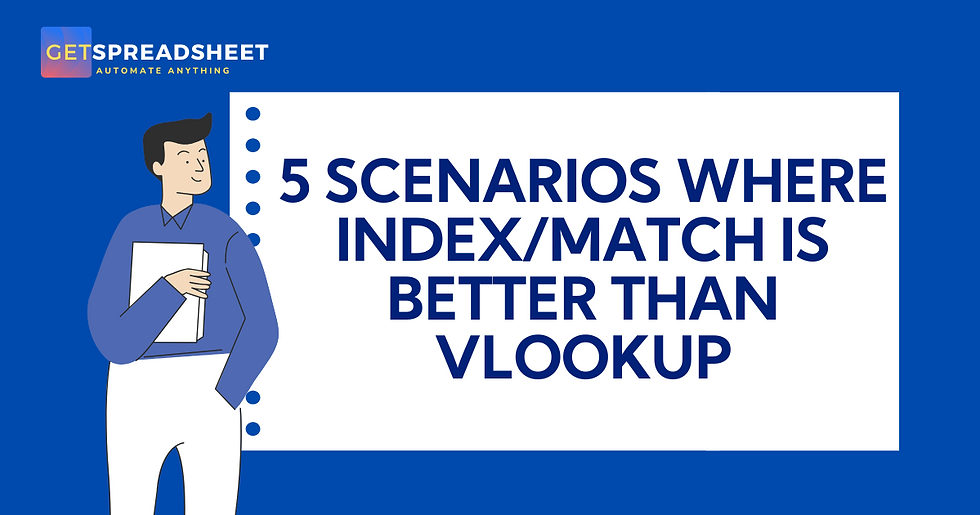5 SCENARIOS WHERE INDEX/MATCH IS BETTER THAN VLOOKUP
- GetSpreadsheet Expert
- Aug 9
- 2 min read
For many years, VLOOKUP was the go-to function for performing lookups in Excel. However, it comes with several limitations that can be frustrating, especially as your spreadsheets grow more complex. The combination of the INDEX & MATCH functions offers a more flexible and robust alternative that solves these problems. By using these functions together, you can create lookup formulas that are more resilient to changes and more powerful in their capabilities.

Here are 5 Scenarios Where INDEX/MATCH is Better than VLOOKUP
LOOKING UP DATA TO THE LEFT VLOOKUP’s biggest limitation is that it can only look up data from left to right. This means your lookup value must be in the first column of the table array. INDEX/MATCH, however, is not bound by this restriction. Because the MATCH function finds the position of your lookup value independently of the INDEX function that returns the result, you can easily look up a value in any column and retrieve data from a column to its left.
PREVENTING ERRORS WHEN INSERTING OR DELETING COLUMNS. A VLOOKUP formula can break if you insert or delete a column within the table array. This is because VLOOKUP uses a fixed column index number to specify which column to return. In contrast, INDEX/MATCH uses a dynamic reference to the entire return column. If you add or remove columns, the formula remains intact because it's still referencing the correct data range, not a hard-coded number.
PERFORMING LOOKUPS ON LARGE DATASETS. For very large datasets, INDEX/MATCH can be significantly faster than VLOOKUP. VLOOKUP needs to process the entire table array in its calculation, which can be computationally intensive. INDEX/MATCH, on the other hand, only has to work with the lookup column and the return column. By reducing the number of cells Excel has to process, you can greatly improve the performance of your spreadsheet.
SUPPORTING MULTIPLE CRITERIA VLOOKUP is designed for a single lookup criterion. If you need to match data based on multiple conditions (e.g., matching a product ID and a date), it becomes much more complicated. With INDEX/MATCH, you can use an array formula to combine multiple MATCH criteria, making it a much more powerful and flexible solution for multi-conditional lookups.
AVOIDING THE 255-CHARACTER LIMIT VLOOKUP has a little-known limitation: the lookup value cannot exceed 255 characters. If your lookup value is a very long string of text, VLOOKUP will fail and return a #VALUE! Error. INDEX/MATCH does not have this limitation, making it the only viable option for performing lookups with long text strings.
While VLOOKUP still has its place, the flexibility and reliability of INDEX/MATCH make it the superior choice for most lookup scenarios. By adopting this powerful combination, you can create more robust and efficient spreadsheets that are less prone to errors and better in handling complex data. What's one scenario where INDEX/MATCH has saved you from a VLOOKUP headache?



Comments